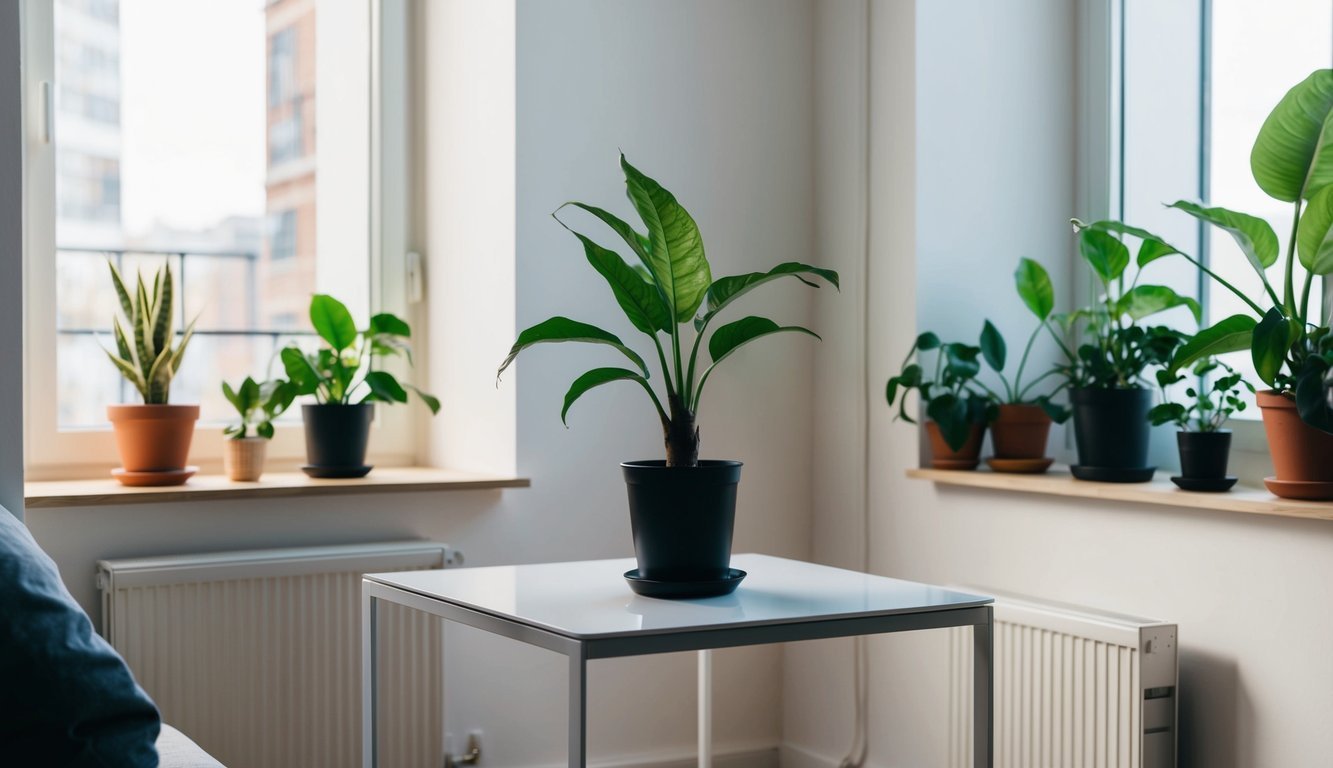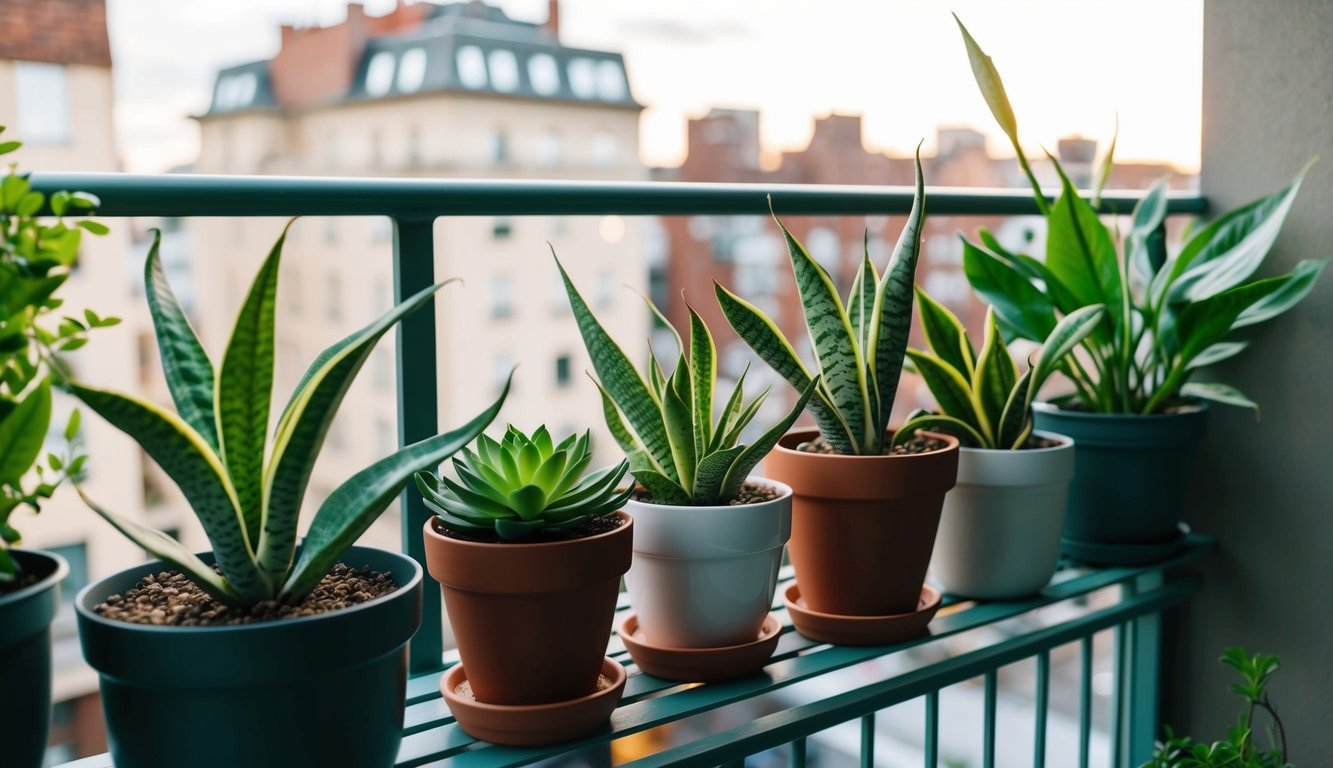When gardening in small spaces, finding the right plants can feel like a challenge.
I’ve discovered that there are plenty of low-effort options that can thrive even in the tightest corners of my home or patio. With minimal maintenance and the right conditions, these plants can bring a splash of life to any small area.

I love how some plants require little attention while still looking great.
Whether you’re a seasoned gardener or just starting out, I’m excited to share some fantastic choices that will make your space feel more vibrant without the hassle.
Let’s dive into these five low-effort plants that fit perfectly in compact environments!
1) Snake Plant
I love having a snake plant around.
It’s one of the easiest plants to care for, making it perfect for small spaces.
This plant can thrive in various light conditions, from low light to bright, indirect sunlight.
What I appreciate most is its durability.
Snake plants can go for a while without water, which suits my sometimes forgetful routine.
They’re not fussy at all and can deal with neglect like a champ.
With its tall, striking leaves, the snake plant also adds a nice touch of green decor.
I enjoy how it fits nicely on my desk or a small shelf.
Plus, it helps purify the air, adding to its charm.
There are different varieties to choose from, so I can pick one that matches my style.
Whether it’s for a cozy corner or a bright windowsill, a snake plant is a fantastic choice to brighten up my space.
Pothos
Pothos is one of my favorite low-effort plants, especially for small spaces.
They’re super adaptable and can thrive in a variety of lighting conditions, from bright, indirect light to low-light areas.
I love how easy they are to care for.
Just water them when the top inch of soil feels dry, and they’re happy.
They can tolerate some neglect, making them perfect if I occasionally forget to tend to them.
The variety of Pothos plants is impressive.
There’s the classic Golden Pothos with its lovely golden leaves, and then there’s the N’Joy Pothos, which features stunning green leaves with white variegation.
Both add a nice touch of greenery to any room.
Not only do they look great, but Pothos are also great air purifiers.
They can help improve the air quality in my home while being low-maintenance.
Whether I place them on a shelf or let them trail down from a hanging planter, they always bring life to my space.
3) Peace Lily
I really enjoy having Peace Lilies in my home.
They’re pretty low-maintenance and thrive in small spaces, making them perfect for apartments or cozy rooms.
These plants can adapt to a variety of light conditions, from low light to bright indirect light.
This flexibility means I can place them in different areas without worrying too much about lighting.
I find that they prefer a consistent watering routine.
I like to make sure the soil stays moist but not soggy.
It’s important to let the top inch of soil dry out between waterings.
One of my favorite things about Peace Lilies is their stunning white flowers.
They’re elegant and effortlessly add a touch of sophistication to any room.
Humidity is another factor to consider.
Peace Lilies enjoy humid conditions, so occasionally misting their leaves can keep them happy.
Plus, they help purify the air, which is an added bonus.
4) Spider Plant
The Spider Plant is one of my favorite low-maintenance plants.
It’s perfect for small spaces and adds a nice touch of greenery.
I love their arching green leaves, often with white stripes.
They thrive in bright, indirect light but can handle lower light conditions too.
Watering is simple; I wait until the top inch of soil feels dry, usually every four to five days.
These plants are forgiving if I occasionally forget to water them.
Spider Plants can grow 12 to 24 inches tall and wide, making them ideal for hanging baskets or shelves.
They even produce “pups,” which I can propagate easily in water.
With such low care needs, the Spider Plant is great for both beginners and seasoned plant lovers.
Plus, they’re known to improve indoor air quality, making my space even nicer.
5) ZZ Plant

The ZZ plant, or Zamioculcas zamiifolia, has become one of my favorite low-effort houseplants.
Its glossy leaves add a touch of elegance to any small space without requiring much maintenance.
I appreciate that this plant can thrive in low light.
While it prefers bright, indirect light, it can tolerate shadier spots too.
This flexibility makes it perfect for various areas in my home.
When it comes to watering, I only do it when the soil is completely dry.
This drought-tolerant plant doesn’t mind being neglected occasionally.
The key is to ensure it sits in well-draining soil to prevent root rot.
I usually mix regular potting soil with sand or perlite for better drainage.
With just occasional fertilization during the growing season, my ZZ plant keeps growing strong and healthy.
It can reach around three feet tall, making it an impressive addition to any room.
Benefits Of Low-Effort Plants

Choosing low-effort plants brings a range of benefits that cater to busy lifestyles and small spaces.
These plants not only save time but also require minimal maintenance, making them ideal for anyone looking to enjoy greenery without the hassle.
Time-Saving Aspects
One of the best parts about low-effort plants is the time I save on gardening tasks.
These plants typically flourish without constant supervision, which means fewer hours spent on upkeep.
-
Less Watering: Many low-effort plants can thrive with less frequent watering. This is a game changer for anyone with a busy schedule.
-
Quick Growth: Fast-growing varieties can fill up a small space quickly without extensive care.
-
Seasonal Resilience: Many low-maintenance plants are hardy, meaning they endure various weather conditions, minimizing the need for constant attention.
Low Maintenance Requirements
I can’t stress enough how low-maintenance these plants are.
They usually need basic care, making them perfect partners for my small living area.
-
Minimal Pruning: Many require no pruning at all or just a light trim. This means I can keep my space looking neat without a major time commitment.
-
Adaptability: Low-effort plants often adapt to various light and soil conditions, so I don’t have to worry about finding the perfect spot in my home.
-
Disease Resistance: These plants are typically more resilient to pests and diseases. With less chance of ongoing problems, I can enjoy a healthier indoor environment.
Tips For Caring In Small Spaces

Caring for plants in small spaces can be a rewarding experience.
I find that optimizing light exposure and using proper watering techniques are essential for keeping my plants healthy and thriving.
Here’s how I manage these elements effectively.
Maximizing Light Exposure
In small spaces, light can be limited, so I focus on maximizing every bit of natural light.
I place my plants near windows whenever possible, adjusting their positions throughout the day to catch the most sunlight.
Consider using sheer curtains to diffuse light without blocking it completely.
If natural light is still lacking, I use grow lights—these can be particularly helpful during winter months or in dimly lit corners.
When choosing plants, I select those that tolerate low light.
Some of my favorites include:
- ZZ Plant
- Pothos
- Chinese Evergreen
This way, I can ensure they still thrive even if I can’t provide direct sunlight.
Proper Watering Techniques
In small spaces, watering is crucial because the roots can quickly become waterlogged in smaller pots.
I follow a simple rule: let the top inch of soil dry out before watering again.
This prevents overwatering and reduces the risk of root rot.
I use pots with drainage holes to allow excess water to escape.
During the warmer months, I check my plants weekly.
But in cooler months, I might stretch it to every two weeks.
It’s helpful to adjust my approach based on the specific needs of each plant.
For example, succulents require less frequent watering than leafy greens.
Keeping a watering schedule can be beneficial in maintaining consistent moisture levels.

